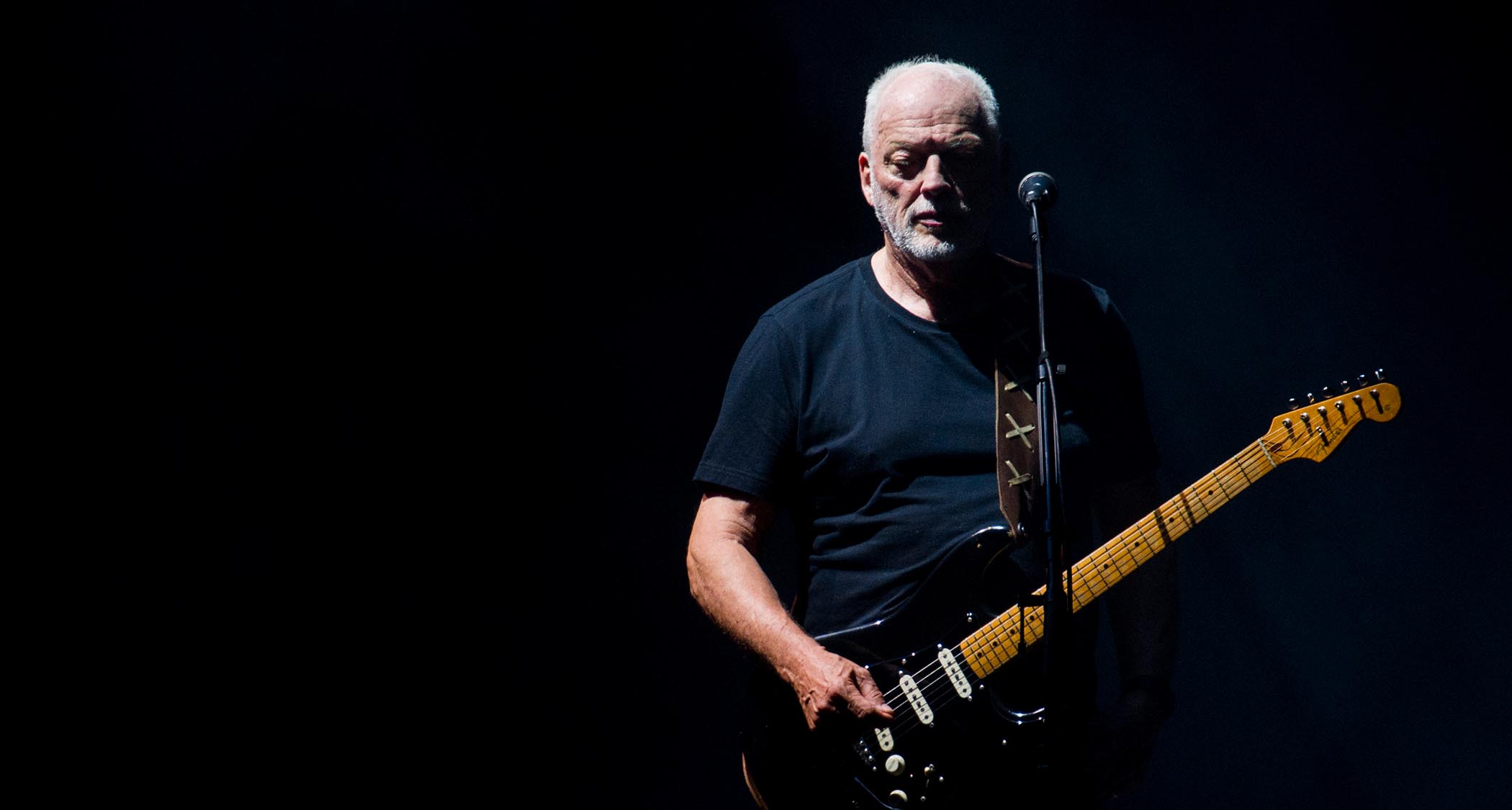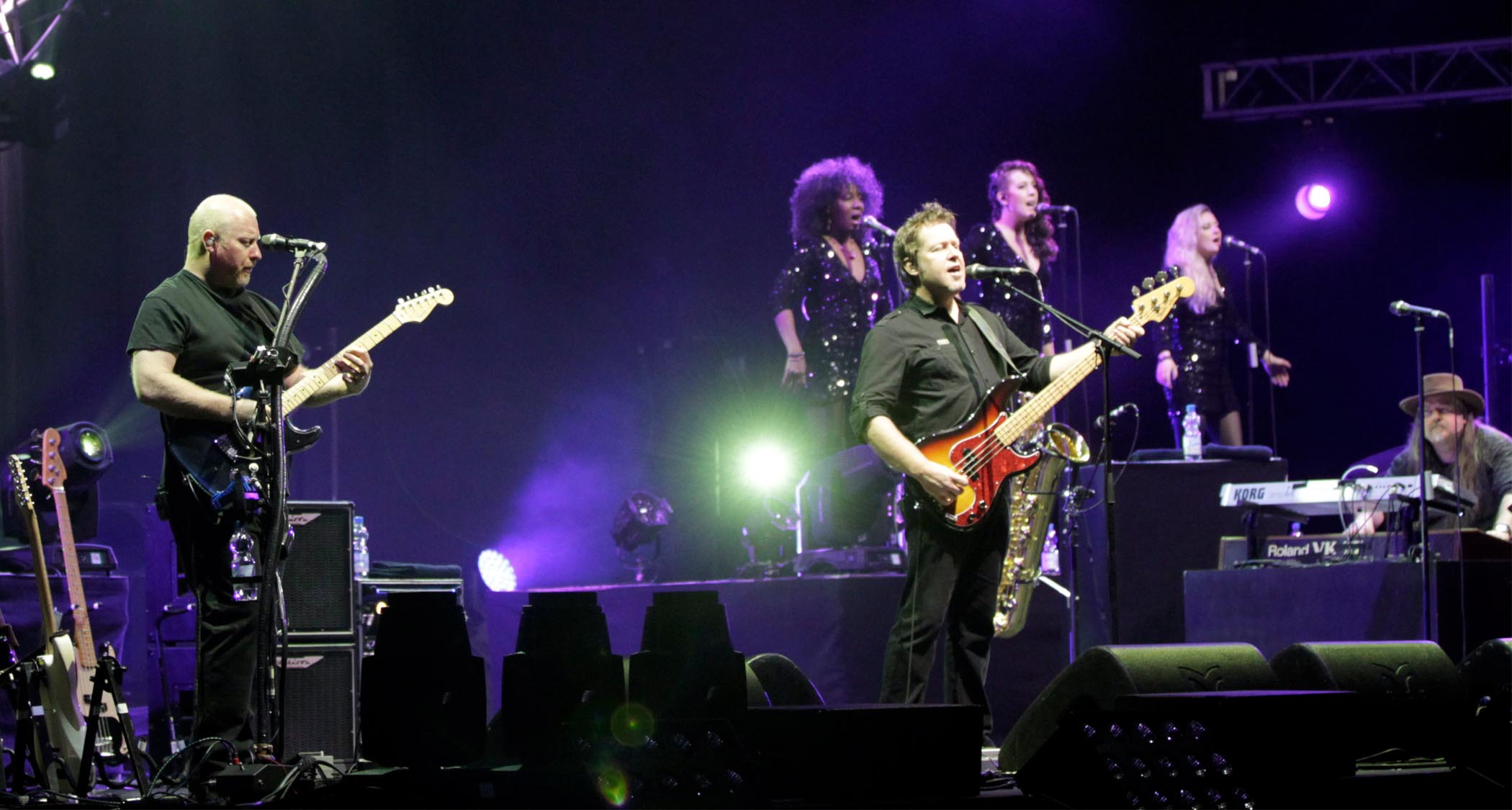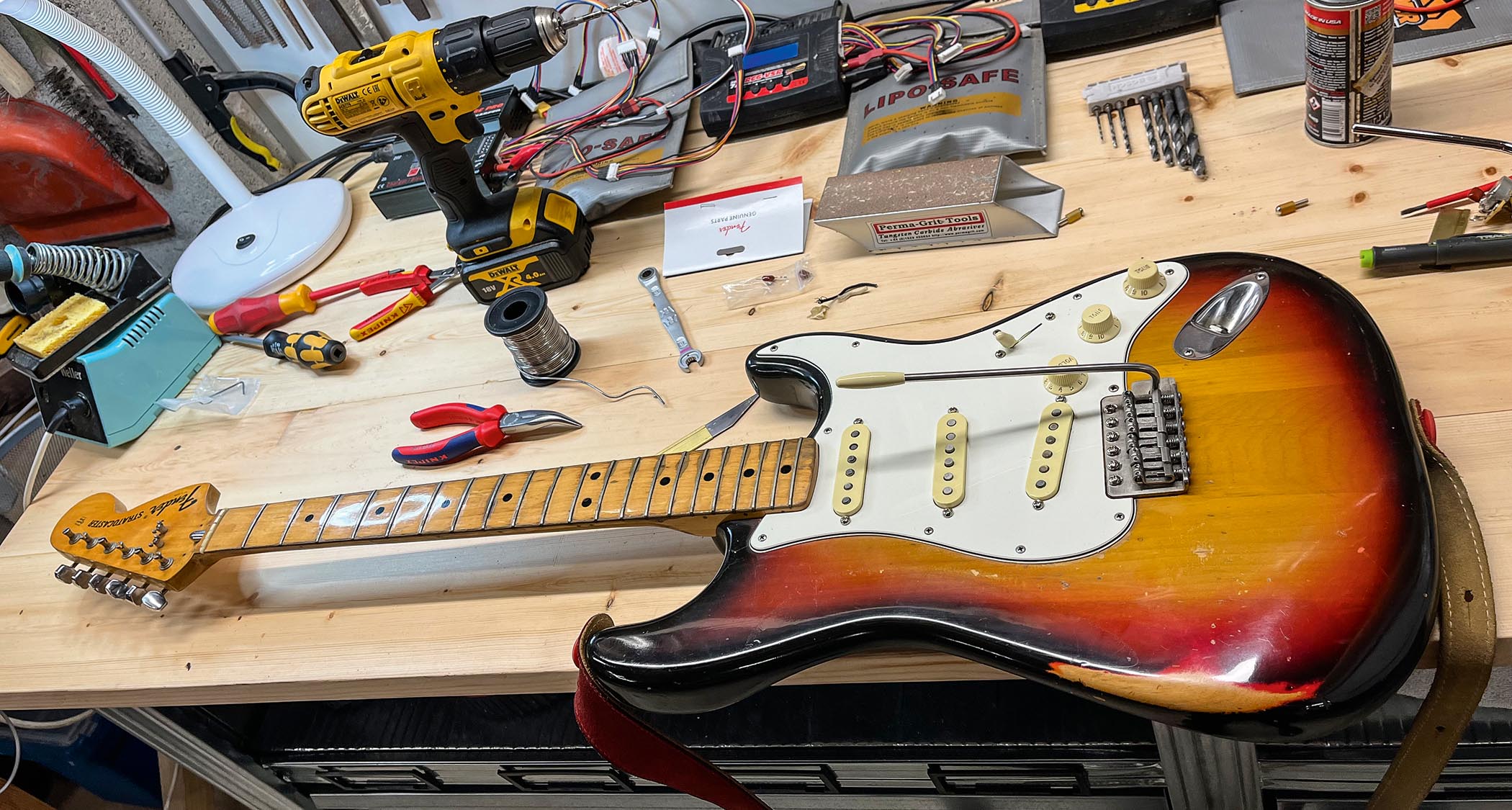
With over five million tickets sold for performances all across the globe, The Australian Pink Floyd Show are undisputed champions when it comes to recreating the music of the world’s most celebrated prog rock band. And they even come with an official stamp of approval – David Gilmour was so impressed by them, he invited the group to perform at his 50th birthday party.
Here, Steve McElroy, the guitarist who helped start the project all the way back in 1988, talks us through the tools needed to emulate those genre-defining sounds and explains why the Pink Floyd guitarist is in a class of his own when it comes to channelling emotion…
David Gilmour and Fender Stratocasters are, quite simply, a match made in heaven. Why do you think the formula works?
“It’s rare to see photographs of David playing anything else, though he has very occasionally used Telecasters and even Les Pauls. He was such a big Hank Marvin fan, so the revered Strat was what he gravitated towards.
“Syd Barrett [original Floyd guitarist and vocalist] played Danelectros and Telecasters, so when David joined, he was expected to use the same instruments, but obviously he had his heart set on the Stratocaster.”

“A big factor was the tremolo arm – the way he uses it is so unique and precise. That guitar clearly gave him the power to unlock the voice he had inside and that sound he wanted to get out. The instrument became an extension of his body.
“It’s funny, David’s wife Polly Samson has said he’s a man of few words at home and tends to speak through his guitar instead. He gets his emotions out through his Strat. Luckily for us, he got a lot of it down on tape and we get to enjoy it!”
It makes perfect sense that such a versatile player would require a versatile instrument…
“That’s it! The number of tones you can get out of a Strat is just incredible. I just saw an old Jeff Beck interview where he’s sitting in a TV studio talking to the host, explaining the extreme versatility of a Stratocaster – from jazzy blues with the tone rolled back on the neck pickup to full-out rock on the bridge, while also backing off the volume to show how it can clean up.
“In two minutes he went through a whole catalogue of sounds and I thought, ‘My god, it’s a phenomenal guitar, isn’t it?!’ Leo Fender and his team knew what they were doing when they built it. And it hasn’t really been improved upon that much since, has it? We’re talking about a 70 year-old design that’s timeless! Think about every song that’s been recorded with one… it’s unbelievable.”
Starting with the instruments in your hands, how do you go about authentically reproducing those legendary Gilmour tones?
“It does, of course, all start with the guitars. That’s the most fundamentally important part of it, along with your hands, the plectrum you use and the strings. I try to get the pots to be the right vintage, with the right type of capacitors in there for the tone circuit.
I just saw an old Jeff Beck interview where he’s sitting in a TV studio talking to the host, explaining the extreme versatility of a Stratocaster... In two minutes he went through a whole catalog of sounds and I thought, ‘My god, it’s a phenomenal guitar, isn’t it?!’
“Then there’s the pickups – Fender had put out a David Gilmour signature Strat with the Seymour Duncan SSL-5 bridge pickup that’s, by all accounts, identical to the Seymour Duncan SSL-1 David had famously used.
“Apparently Seymour dropped off a shoebox full of pickups to [Gilmour’s long-serving tech] Phil Taylor. Him and David went through all of them until they found ‘the one’. It was just a lucky dip – and that pickup ended up being the sound of his black Strat. So I’ve used those replicas in the bridge. I also have other guitars with stacked versions so I can switch to a humbucker if I need to…”

That’s interesting. What kind of scenarios would call for that?
“It’s not for gain purposes. I try to retain the single-coil sound as much as possible, but some stages have a lot of electrical interference from the lights. You might have a transformer the size of a fridge underneath where you are stood. There’s nothing you can do about that, other than switch to humbucker and hope for the best!
“Other guitars have the EMG DG20 system, which is the active stuff David used from the A Momentary Lapse Of Reason tour onwards. He’s since gone back to the passive setup over the last 15 years. Another guitar has a ’70s DiMarzio FS-1 pickup. David had that in a Strat for his first solo album in 1978, some of The Final Cut and some tracks on The Wall.”
On this journey I’ve had, when you find a piece of equipment that puts you in a zone, you think, ‘Wow, David had this and it clearly influenced what came out of him!’
Some have said that’s what he played the Comfortably Numb solo with.
“He’s since resorted back to the Seymour Duncan in the black Strat, which, of course, has now been auctioned off for a lovely cause. But the DiMarzio has quite an aggressive, more middy and poking sound. They’re as rare as hen’s teeth but I was given one a few years ago by a collector friend.
“As soon as I put it in a guitar, it sounded exactly like the tone on Animals. It was almost conducive – it made you want to play in a certain way that matched that album.
“On this journey I’ve had, when you find a piece of equipment that puts you in a zone, you think, ‘Wow, David had this and it clearly influenced what came out of him!’ I know it’s the chicken or the egg, but I always feel like whatever he uses, he can always squeeze the most out of it.”
Is there any special insight you’ve had into how David Gilmour works and his approach to finding the right melody?
“I’ve had some contact with Phil Taylor. I was up fixing my roof one day and my mobile phone rang. It was Phil saying, ‘Steve, we’re trying to find an old Colorsound Power Boost, the old 18V one from the ’60s/’70s, have you got one we can use?’ And I had loads in, but not the specific model they were looking for. So I helped them track one down in London through another collector friend.
“While I was on the phone, there was this loud noise in the background going off that sounded like an alarm. I had to ask Phil about it, just to find out what is going on back there and he told me it was David, who had been relentlessly working on one note all day long for two weeks! It made me laugh, but I realised that’s why every note is perfect. That’s how dedicated he is.”
You must have a sizeable pedalboard, particularly when it comes to fuzz, modulation and delays.
“I use two of the Pete Cornish fuzz pedals – there’s the P-1 and the P-2. I also use a ’70s Electro-Harmonix Ram’s Head Big Muff, but it’s got to have a specific transistor to get the right sound. I also use Thorpy fuzz pedals.
“There’s the Veteran which comes in both germanium and silicon. I needed both because the germanium sounds beautiful but falls down and dies when it’s hot. Then I’ll dig the silicon out, which doesn’t sound quite as good but it’s 80 percent there.
“After doing this for 36 years, I have boxes and boxes of fuzz pedals. I’m on the hunt for the Holy Grail! You can buy 10 of the same and they’ll all sound different, maybe they’ve been repaired or tweaked or were made on a Friday instead of a Monday. You can’t just grab a vintage pedal and expect it to be exactly the same as another.”
What other pedals are an absolute necessity?
“I use proper Leslies mic’d up for certain modulation sounds, then there’s also the Electric Mistress Flanger and CE-2 Chorus. Anything David has used, I’ve bought at some point.
“The ones I couldn’t live without are the Colorsound Power Boost and the Pete Cornish SS-2 Soft Sustain Overdrive. Compression-wise, there’s a ’70s MXR Dyna Comp with the script logo, which gives you that beautiful attack for clean tones, and there’s a Boss CS-2. For this gig, you need a lot of boosts, compression and fuzz.”
To picture David Gilmour’s solos, they’re tumbling and falling but always remain graceful and beautiful, like athletes in the Olympics
What are the defining characteristics of David’s lead work? A lot of people might say it’s the slower bends and vibrato, and general sense of minimalism…
“Definitely the pitching of his bends, which is just razor sharp. It’s the feel of it and the timing – he dances around the beat a lot of the time. He might come in late or have notes hang over instead of resolving on the beat. To picture David Gilmour’s solos, they’re tumbling and falling but always remain graceful and beautiful, like athletes in the Olympics. His ideas always fit perfectly.
“I’ve read interviews where he’s said he’ll absorb the music first before even thinking of a note. He’ll just listen to the music around the house for a week or so, walking around, coming up with melodies in his head, whistling or humming them out. That’s why he always plays for the song rather than saying, ‘Look what I can do!’ and trying to fit in as many notes in as possible. It’s always complementary. I think he visualises the solos in the context of the song.”
There’s definitely a visual element, isn’t there?
“I remember talking to Dick Parry who played saxophone on the Floyd albums. He told me that when he went to record the song Money, Roger [Waters, Floyd bassist/vocalist] and David were sitting there explaining what the music was all about.
“David had figured out his guitar solo and was telling Dick he chose those notes while imagining a big fat businessman who was greedy, looking down on people while laughing at them.
“He conveyed that through his guitar and you can really feel it in the solo. That’s his approach to it, always very relatable. He makes us feel things. His solos have a sense of humanity that can cross all barriers of race and culture. It’s a very humble approach. His role is to serve the song, not to self-promote.”
So what exactly are your favourite leads to play with the band?
“I love all of Shine On You Crazy Diamond. The opening solo is just so pure. It’s also using a different tremolo technique – he’s palming the bar instead of grabbing it and warbling it up and down. Instead of the sine wave going up and below, it’s only going below and rising up to pitch. It has its own sound but it sounds so beautiful.
I love all of Shine On You Crazy Diamond. The opening solo is just so pure. It’s also using a different tremolo technique – he’s palming the bar instead of grabbing it and warbling it up and down
“It’s a very intimate part, especially when you think about what the song is about: the sadness of Syd Barrett and his demise. The emotion was just coming through. David went for a bluesy sound on the neck pickup. That opening riff four note idea is so iconic and magnificent on its own. The sound he dialled in is just perfection…”
Guitar tones don’t come much more legendary! But is it a Uni-Vibe or a phaser pedal along with the Leslie?
“A lot of people argue over that! I think it’s a Uni-Vibe myself. I’ve tried both, and I actually use all three to get the right motion, blended in parallel. I also love the song Echoes, which is 20 minutes long with all these masterful guitar parts. Then there’s Dogs from the Animals album, which has some wonderful guitar work. But it’s all amazing! Catch me on a different day and other ones will jump out.”
- The Australian Pink Floyd Show begin a UK tour in October.







